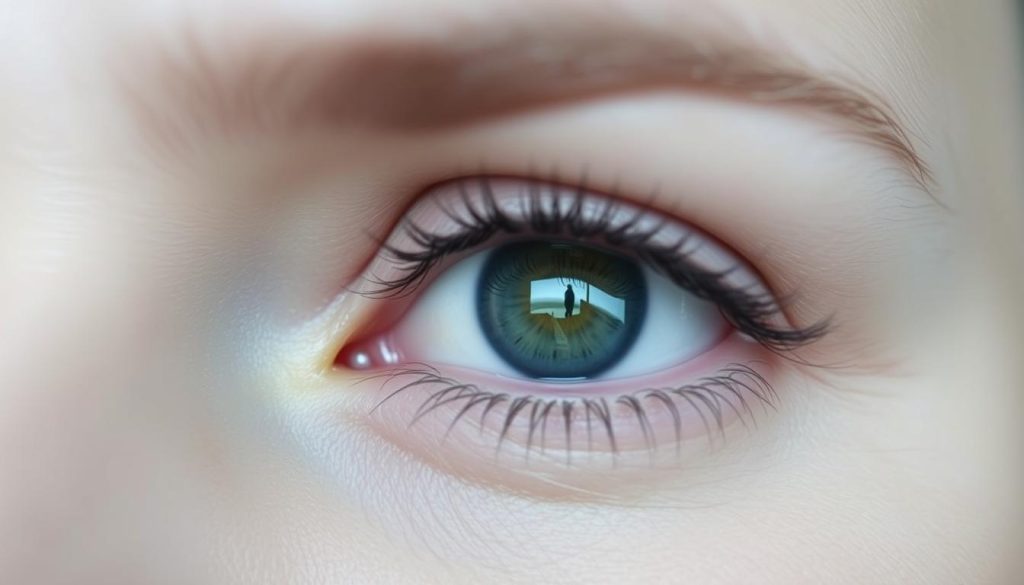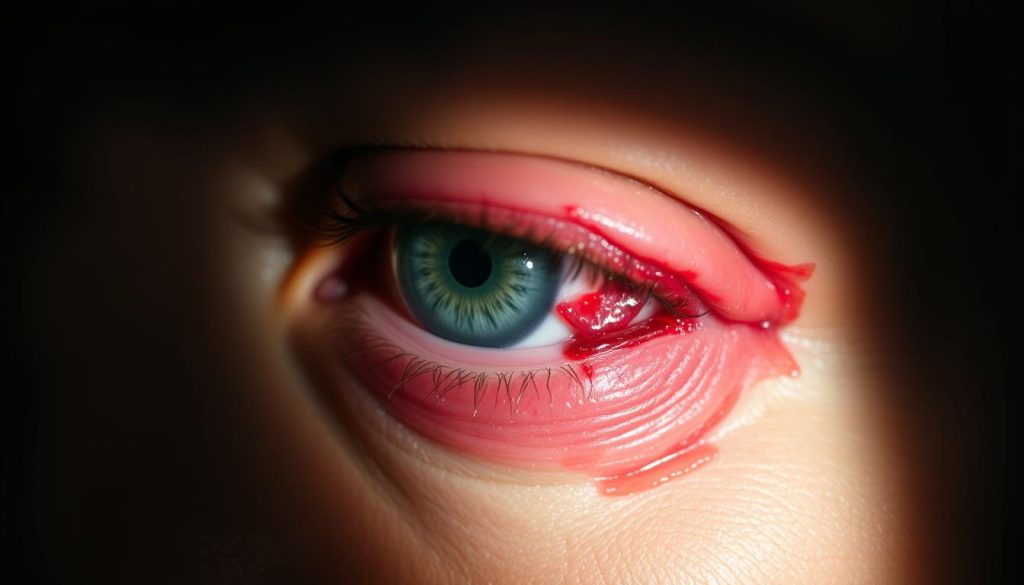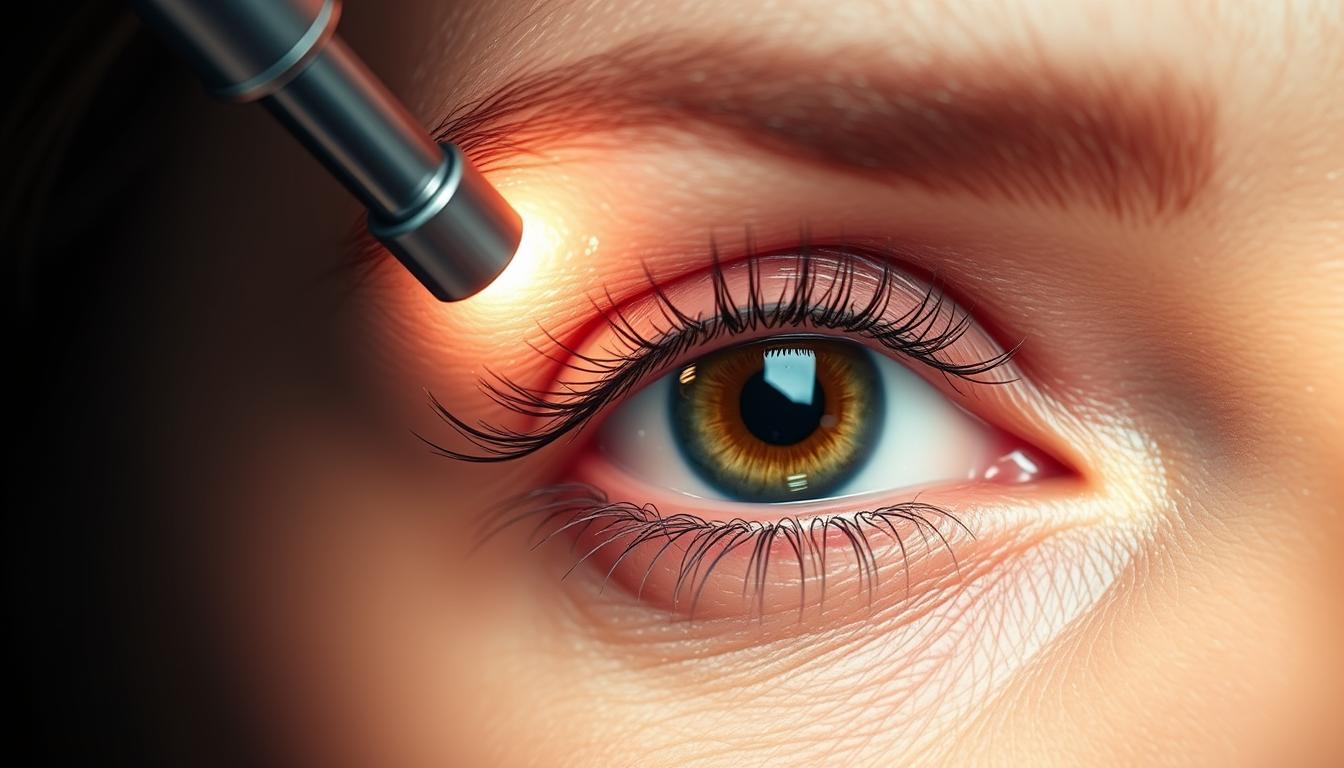Eyelid lift surgery, or blepharoplasty, is a highly individualized procedure designed to rejuvenate the appearance of the eyes by addressing sagging skin, smooth wrinkles, and reduce puffiness around the upper and lower eyelids.
This comprehensive guide will explore the science behind blepharoplasty, the different types of eyelid surgeries available, and help you determine which might be right for your specific needs, whether you’re considering it for cosmetic reasons or to address functional issues.
Key Takeaways
- Understand the benefits and aspects of eyelid lift surgery.
- Learn about the different types of blepharoplasty procedures.
- Discover how eyelid surgery can address sagging skin and puffiness.
- Find out what to expect during the recovery process.
- Determine if eyelid lift is right for your needs.
Understanding Blepharoplasty: The Science Behind Eyelid Surgery
With the skin around the eyes being the thinnest on the body, it’s no surprise that blepharoplasty has become a popular choice for those looking to combat aging.
What Is Eyelid Surgery?
Blepharoplasty, or eyelid surgery, is a procedure that involves the removal of excess skin, fat, and muscle from the upper and/or lower eyelids to improve the appearance of the eyes.
Why the Eyes Show Aging First
The skin around the eyes is particularly vulnerable to aging due to several factors:
- The skin around the eyes is approximately 0.5mm thick, making it the thinnest skin on the entire body.
- This delicate eyelid skin contains fewer oil glands, resulting in less natural moisture.
- Environmental factors like sun exposure and smoking accelerate the breakdown of collagen and elastin.
- The constant movement of the eyelids contributes to skin laxity and muscle weakening.
- Genetic factors play a significant role in how quickly the eye area ages.
Types of Eye Surgery to Lift Eyelids
There are several types of eye surgery that can help lift and restore the eyelids. Eyelid blepharoplasty is a versatile procedure that can be tailored to individual needs, addressing various concerns related to the upper and lower eyelids.
Upper Eyelid Blepharoplasty
Upper eyelid blepharoplasty focuses on correcting issues such as drooping eyelids, excess skin, and fat deposits that can make the eyes appear tired or aged. The procedure involves removing or repositioning fat, tightening muscles, and eliminating excess skin to reveal a more alert and youthful appearance.
Lower Eyelid Blepharoplasty
Lower eyelid blepharoplasty targets concerns such as under-eye bags, wrinkles, and sagging skin. The surgery often involves repositioning or removing fat pads, tightening muscles and tendons, and eliminating excess skin to create a smoother, more youthful shape beneath the eyes.
| Technique | Description | Benefits |
|---|---|---|
| Transcutaneous Approach | Incision just below the lash line | Effective for addressing excess skin and fat |
| Transconjunctival Approach | Incision inside the lower eyelid | Reduces risk of visible scarring |
The choice of technique depends on the patient’s specific needs and the surgeon’s professional judgment.
Key Benefits of Eyelid Lift Surgery
Patients who undergo eyelid lift surgery often experience both aesthetic and practical benefits that enhance their quality of life. This surgery is not just about improving appearance; it also addresses functional issues related to vision and comfort.
Cosmetic Improvements
Eyelid lift surgery can significantly enhance the appearance of the eyes by removing excess skin and fat, resulting in a more youthful and alert look. The procedure can reduce the signs of aging, making individuals look more rested and vibrant. By rejuvenating the area around the eyes, patients can achieve a more refreshed appearance that boosts their confidence.
Functional Benefits
If sagging eyelid skin is obstructing your ability to see, eyelid surgery can eliminate the problem and allow you to more fully open your eyes. For many patients with significant upper eyelid hooding, blepharoplasty can substantially improve peripheral vision that was previously obstructed by excess skin. The improvement in visual field can enhance daily activities such as driving, reading, and using digital devices with greater comfort and safety. 
The functional improvements from eyelid surgery are so significant that insurance may cover the procedure when vision impairment can be documented through visual field testing. By alleviating the weight of heavy upper eyelids, patients can reduce eye strain and discomfort, leading to an overall improvement in their quality of life.
Ideal Candidates for Eyelid Surgery
Understanding who makes an ideal candidate for eyelid surgery is crucial for achieving successful outcomes. The suitability of a patient for blepharoplasty depends on various factors, including their overall health, the condition of their eyelids, and their skin’s elasticity.
Medical Considerations
Patients with certain medical conditions may not be ideal candidates for eyelid surgery. Significant eye conditions can complicate the procedure or the recovery process. Ideal candidates are typically those without such conditions, ensuring a smoother surgery and recovery.
Age and Skin Condition Factors
While there’s no strict age limit, most patients are over 35 when skin laxity and fat displacement become more noticeable. Candidates should have good skin elasticity for optimal results. Key factors include:
- Age: Typically over 35 years old.
- Skin Condition: Good elasticity is crucial.
- Genetic predispositions can influence candidacy.
- Non-smokers or those willing to quit smoking are preferred.
Finding a Qualified Surgeon for Your Eyelid Lift

Finding a qualified surgeon for your eyelid lift is a decision that requires careful consideration. The right surgeon can significantly impact the outcome of your eyelid surgery.
Board Certification and Specialization
When searching for a surgeon, it’s crucial to look for board certification and specialization in eyelid surgery. A certified surgeon has undergone rigorous training and has the necessary expertise to perform the procedure.
Evaluating Before and After Results
Examining a surgeon‘s portfolio of before and after photos provides valuable insight into their aesthetic style and technical skill with eyelid surgery. Pay particular attention to results from patients with similar facial features to yours. A skilled surgeon will have consistent results across different patient types.
Some key points to consider when evaluating a surgeon’s previous work include:
- Patients with similar facial features, ethnicity, age, and concerns to yours.
- Multiple examples of fully healed results (at least 6-12 months post-surgery).
- Consistent, natural-looking eyelid contours.
Preparing for Your Eyelid Surgery
Preparing for eyelid surgery involves several crucial steps that patients must follow to ensure a smooth procedure. This preparation is key to minimizing risks and achieving a successful outcome.
Medical Evaluation and Planning
It’s essential that patients discuss all medications and supplements with their doctor, as some may need to be adjusted to reduce bleeding risks. A thorough medical evaluation will help identify any potential issues that could affect the surgery.
Pre-Surgery Checklist
To ensure a smooth recovery, patients should follow a pre-surgery checklist. This includes stopping blood-thinning medications at least two weeks before surgery, arranging for transportation home after the procedure, and preparing their recovery space at home with essentials. Patients should also follow specific instructions regarding fasting before surgery, typically avoiding food and drink for at least 8-12 hours prior to anesthesia, and quit smoking at least four weeks before to minimize complication risks, thus making the most of their time during recovery.
The Blepharoplasty Procedure: Step by Step
Understanding the steps involved in theblepharoplastyprocedure can help alleviate concerns for prospective patients. The process is designed to be as smooth and efficient as possible.
Anesthesia Options
The procedure typically begins with the administration of anesthesia to ensure the patient’s comfort. Options may include local anesthesia with sedation or general anesthesia, depending on the complexity of the case and the patient’s preference.
Surgical Techniques
The surgical technique used in blepharoplasty can vary depending on whether the upper or lower eyelids are being addressed. The surgeon will make precise incisions along the natural creases of the eyelids to minimize visible scarring.
Duration and Immediate Post-Op
The time required for the procedure can range from 45 minutes to 2 hours, depending on the specifics of the surgery. After the surgery, patients are monitored in a recovery area until the effects of anesthesia begin to wear off. Key aspects of the immediate post-operative period include:
- Monitoring in a recovery area for 1-2 hours
- Application of cold compresses to minimize swelling
- Temporary blurred vision due to lubricating ointments
- Detailed instructions for at-home care and medication schedules
Recovery Timeline After Eyelid Surgery
Understanding the recovery timeline after eyelid surgery is crucial for patients to manage their expectations and plan their post-operative care effectively. The recovery process involves several stages, each with its own set of milestones and expectations.
First 48 Hours Post-Surgery
The initial 48 hours after eyelid surgery are critical. Patients typically experience swelling, bruising, and discomfort, which can be managed with cold compresses and prescribed medication. Rest is essential during this period to facilitate the healing process.
Week One Through Two
During the first two weeks, patients can expect the swelling to gradually subside, and the eyelids to start feeling more normal. Most patients can resume wearing contact lenses around 10 to 14 days post-surgery, but this should be confirmed with their surgeon. Strenuous activities should be avoided for at least two to three weeks.
Complete Healing Process
The complete internal healing process continues for several months after the procedure. Final results typically emerge around three to six months post-surgery, when all residual swelling has resolved and tissues have fully settled. It’s also important to note that scars continue to mature and fade for up to a year.
| Recovery Stage | Timeline | Key Milestones |
|---|---|---|
| Initial Recovery | 0-48 hours | Manage swelling and bruising, rest |
| Gradual Improvement | 1-2 weeks | Resume contact lens wear, avoid strenuous activities |
| Complete Healing | 3-6 months | Final results emerge, tissues fully settle |
By understanding the recovery timeline and adhering to their surgeon’s instructions, patients can ensure a smooth and successful healing process, ultimately achieving the desired results from their eyelid surgery.
Managing Post-Surgical Care
After undergoing eyelid surgery, managing post-surgical care is crucial for optimal recovery. Proper care ensures that the healing process is smooth and that complications are minimized.
Reducing Swelling and Discomfort
To reduce swelling and discomfort after eyelid surgery, patients are advised to follow specific post-operative instructions. Applying cold compresses and keeping the head elevated can significantly reduce swelling. It’s also essential to follow the medication regimen prescribed by the surgeon to manage pain and discomfort effectively.
Activity Restrictions
Activity restrictions play a vital role in the recovery process. Patients should avoid bending at the waist, heavy lifting (over 10 pounds), and strenuous exercise for at least 2-3 weeks to prevent increased blood pressure that could cause bleeding or increased swelling. Here are some key activity restrictions to follow:
- Limit work involving computers and reading during the first week, taking frequent breaks to rest the eyes.
- Avoid swimming, hot tubs, and environments with excessive dust or irritants for at least 3-4 weeks.
- Refrain from driving until vision is completely normal and no longer taking prescription pain medication, usually around 7-10 days.
- Gradually return to normal activities, with most patients resuming their full pre-surgery routine, including vigorous exercise, by 4-6 weeks.
| Activity | Restriction Time |
|---|---|
| Bending, Heavy Lifting, Strenuous Exercise | 2-3 weeks |
| Swimming, Hot Tubs | 3-4 weeks |
| Driving | 7-10 days |
| Full Pre-Surgery Routine | 4-6 weeks |
Potential Risks and Complications
Understanding the potential risks and complications associated with eyelid surgery is crucial for informed decision-making. While generally considered safe, eye surgery carries certain risks that patients should be aware of.
Common Side Effects
Common side effects of eyelid surgery include temporary swelling, bruising, and dryness of the eye. These effects are usually mild and resolve on their own within a few days. Adhering to the surgeon‘s postoperative care instructions is crucial for minimizing these effects.
Serious Complications to Watch For
Serious complications, although rare, can occur. Patients should be vigilant for signs of infection, excessive bleeding, or vision changes, including double vision or severe blurring. If any of these symptoms persist or worsen, patients should seek immediate medical attention.

Combining Eyelid Surgery with Other Procedures
Eyelid surgery, when paired with other facial rejuvenation techniques, can offer a more holistic approach to addressing the signs of aging around the eyes. This comprehensive strategy allows patients to achieve a more youthful and refreshed appearance.
Brow Lifts and Facelifts
Combining eyelid surgery with brow lifts or facelifts can significantly enhance the overall outcome. A brow lift can address sagging eyebrows, while a facelift can target deeper facial wrinkles, creating a smoother, more rejuvenated look. These procedures can be tailored to individual needs, ensuring a personalized approach to facial rejuvenation.
Non-Surgical Complementary Treatments
Non-surgical treatments, such as Botox or dermal fillers, can complement eyelid surgery by addressing wrinkles and volume loss around eyes. Some common complementary treatments include:
- Botulinum toxin injections to relax dynamic wrinkles
- Dermal fillers to address volume loss
- Laser skin resurfacing or chemical peels to improve skin texture
These treatments can enhance the results ofprocedureslikeeyelidsurgery, providing a more comprehensive anti-aging solution.
| Treatment | Benefits |
|---|---|
| Brow Lift | Addresses sagging eyebrows, enhancing facial rejuvenation |
| Facelift | Targets deeper facial wrinkles, creating a smoother appearance |
| Botox/Dermal Fillers | Relaxes dynamic wrinkles and addresses volume loss |
Long-Term Results and Maintenance
Blepharoplasty can offer enduring results, enhancing the appearance of the eyes for years to come. With a healthy lifestyle and good skincare habits, the results of cosmetic eyelid lift surgery should last for years.
Several factors contribute to the longevity of eyelid surgery results. These include:
- The duration of upper and lower eyelid lift results, which can last 5-7 years and over a decade, respectively.
- The continued progression of the aging process, which is slowed down but not halted by surgery.
- The use of high-quality skincare products containing retinoids, antioxidants, and sunscreen to maintain appearance.
- Lifestyle factors such as sun protection, smoking cessation, proper hydration, and a healthy diet.
- Periodic non-surgical treatments like Botox, dermal fillers, or energy-based skin tightening to enhance results.
By combining these factors, individuals can enjoy long-lasting eyelid lift results, maintaining a more youthful appearance around their eyes.
FAQ
What is the purpose of upper eyelid blepharoplasty?
Upper eyelid blepharoplasty is performed to remove excess skin and fat from the upper eyelid, improving the appearance of the eyes and, in some cases, addressing functional issues such as ptosis, where the eyelid droops.
How long is the recovery process after blepharoplasty?
The recovery process typically takes several weeks, with most patients experiencing significant improvement within the first two weeks. Swelling and bruising are common during this time, but these symptoms gradually subside.
Are there any risks or complications associated with eyelid surgery?
As with any surgical procedure, there are potential risks and complications, including infection, scarring, and vision problems. However, when performed by a qualified and experienced surgeon, these risks are minimized.
Can blepharoplasty be combined with other cosmetic procedures?
Yes, blepharoplasty can be combined with other procedures, such as brow lifts or facelifts, to achieve a more comprehensive facial rejuvenation. This approach can be beneficial for individuals seeking to address multiple signs of aging.
How long do the results of eyelid surgery last?
The results of eyelid surgery can last for many years, depending on individual factors such as skin condition, lifestyle, and the natural aging process. While the procedure cannot stop aging entirely, it can significantly improve the appearance of the eyes for an extended period.
What are the key benefits of undergoing eyelid lift surgery?
The key benefits include improved appearance, enhanced vision (in cases where excess skin obstructs the visual field), and a more youthful and alert look. The procedure can also boost self-confidence and overall satisfaction with one’s appearance.
